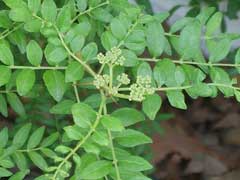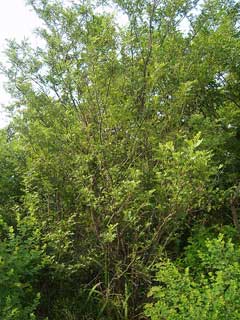 |
|
commons.wikimedia.org/wiki/User:Dalgial |
 |
| commons.wikimedia.org/wiki/User:Dalgial |
Translate this page:
Summary
Yellow autumn colour. Valuable for butterflies
Physical Characteristics

 Zanthoxylum schinifolium is a deciduous Shrub growing to 4 m (13ft 1in).
Zanthoxylum schinifolium is a deciduous Shrub growing to 4 m (13ft 1in).
See above for USDA hardiness. It is hardy to UK zone 6. It is in flower from July to August, and the seeds ripen in October. The plant is not self-fertile.
Suitable for: light (sandy), medium (loamy) and heavy (clay) soils and prefers well-drained soil. Suitable pH: mildly acid, neutral and basic (mildly alkaline) soils. It can grow in semi-shade (light woodland) or no shade. It prefers moist soil. The plant can tolerates strong winds but not maritime exposure.
UK Hardiness Map
US Hardiness Map
Synonyms
Fagara pteropoda. Zanthoxylum mantschuricum. Zanthoxylum pteropodum
Plant Habitats
Woodland Garden Sunny Edge; Dappled Shade; Shady Edge;
Edible Uses
Edible Parts: Leaves
Edible Uses: Condiment
Seed - cooked. It is used as a condiment, a pepper substitute[151]. Young leaves[105]. No more details are given.
References More on Edible Uses
Medicinal Uses
Plants For A Future can not take any responsibility for any adverse effects from the use of plants. Always seek advice from a professional before using a plant medicinally.
Anaesthetic Diuretic Parasiticide Stimulant Tonic Vasodilator
The pericarp is anaesthetic, diuretic, parasiticide and vasodilator[176]. It is used in the treatment of gastralgia and dyspepsia due to cold with vomiting, diarrhoea, abdominal pain, ascariasis and dermal diseases[176]. It has a local anaesthetic action and is parasiticide against the pork tapeworm (Taenia solium)[176]. The pericarp contains geraniol. In small doses this has a mild diuretic action, though large doses will inhibit the excretion of urine[176]. There is a persistent increase in peristalsis at low concentration, but inhibition at high concentration[176]. The resin contained in the bark, and especially in that of the roots, is powerfully stimulant and tonic[82].
References More on Medicinal Uses
The Bookshop: Edible Plant Books
Our Latest books on Perennial Plants For Food Forests and Permaculture Gardens in paperback or digital formats.

Edible Tropical Plants
Food Forest Plants for Hotter Conditions: 250+ Plants For Tropical Food Forests & Permaculture Gardens.
More

Edible Temperate Plants
Plants for Your Food Forest: 500 Plants for Temperate Food Forests & Permaculture Gardens.
More

More Books
PFAF have eight books available in paperback and digital formats. Browse the shop for more information.
Shop Now
Other Uses
References More on Other Uses
Cultivation details
Uses: Clearstem tree, multi-stem tree, specimen tree, specimen shrub; Parks, tree containers, cemeteries, roof gardens, large gardens. Prefers a good deep well-drained moisture retentive soil in full sun or semi-shade[1, 11, 200]. Flowers are formed on the old wood[206]. Dioecious. Male and female plants must be grown if seed is required. Self-sown seedlings have occasionally been observed growing in bare soil in the shade of the parent plant[K].
References Carbon Farming Information and Carbon Sequestration Information
Temperature Converter
Type a value in the Celsius field to convert the value to Fahrenheit:
Fahrenheit:
The PFAF Bookshop
Plants For A Future have a number of books available in paperback and digital form. Book titles include Edible Plants, Edible Perennials, Edible Trees,Edible Shrubs, Woodland Gardening, and Temperate Food Forest Plants. Our new book is Food Forest Plants For Hotter Conditions (Tropical and Sub-Tropical).
Shop Now
Plant Propagation
Seed - best sown in a greenhouse as soon as it is ripe in the autumn. Stored seed may requires up to 3 months cold stratification, though scarification may also help[113]. Sow stored seed in a cold frame as early in the year as possible. Germination should take place in late spring, though it might take another 12 months. Prick out the seedlings into individual pots when they are large enough to handle and grow them on in a cold frame for their first winter. Plant them out in early summer. Cuttings of half-ripe wood, July/August in a frame. Root cuttings, 3cm long, planted horizontally in pots in a greenhouse. Good percentage[78]. Suckers, removed in late winter and planted into their permanent positions[113].
Other Names
If available other names are mentioned here
Native Range
TEMPERATE ASIA: China (Anhui Sheng, Zhejiang Sheng, Fujian Sheng, Henan Sheng, Hebei Sheng, Hunan Sheng, Hubei Sheng, Jiangxi Sheng, Jiangsu Sheng, Guangdong Sheng (north), Guizhou Sheng, Liaoning Sheng, Shandong Sheng, Guangxi Zhuangzu Zizhiqu (north)), Korea, Japan (Honshu, Kyushu, Ryukyu Islands, Shikoku), Taiwan
Weed Potential
Right plant wrong place. We are currently updating this section.
Please note that a plant may be invasive in one area but may not in your area so it's worth checking.
Conservation Status
IUCN Red List of Threatened Plants Status :

Growth: S = slow M = medium F = fast. Soil: L = light (sandy) M = medium H = heavy (clay). pH: A = acid N = neutral B = basic (alkaline). Shade: F = full shade S = semi-shade N = no shade. Moisture: D = dry M = Moist We = wet Wa = water.
Now available:
Food Forest Plants for Mediterranean Conditions
350+ Perennial Plants For Mediterranean and Drier Food Forests and Permaculture Gardens.
[Paperback and eBook]
This is the third in Plants For A Future's series of plant guides for food forests tailored to
specific climate zones. Following volumes on temperate and tropical ecosystems, this book focuses
on species suited to Mediterranean conditions—regions with hot, dry summers and cool, wet winters,
often facing the added challenge of climate change.
Read More
Expert comment
Author
Siebold.&Zucc.
Botanical References
58200
Links / References
For a list of references used on this page please go here
Readers comment
| Add a comment |
|
If you have important information about this plant that may help other users please add a comment or link below. Only comments or links that are felt to be directly relevant to a plant will be included. If you think a comment/link or information contained on this page is inaccurate or misleading we would welcome your feedback at [email protected]. If you have questions about a plant please use the Forum on this website as we do not have the resources to answer questions ourselves.
* Please note: the comments by website users are not necessarily those held by PFAF and may give misleading or inaccurate information.
To leave a comment please Register or login here All comments need to be approved so will not appear immediately.
|
Subject : Zanthoxylum schinifolium
|
|
|
|